Extension of Pin-Based Point-Wise Energy Slowing-Down Method for VHTR Fuel with Double Heterogeneity
Abstract
1. Introduction
2. Methods
2.1. Simple Review of Pin-Based Point-Wise Slowing down Method
2.2. Pointwise Energy Slowing down Method for a DH Region
2.3. Improvement of Calculation Speed for Collision Probability of Spherical Unit Cell
2.4. Reconstruction of Nuclide Number Densities for Depletion Calculation in a DH Region
2.5. Calculation Procedure of DeCART with PSM-DH
3. Numerical Results
3.1. MHTGR-350 Benchmark Problems
3.2. Large Size Compact and Various Size TRISO Problems
3.3. Computational Efficiency for PSM-DH
4. Conclusions
Author Contributions
Funding
Institutional Review Board Statement
Informed Consent Statement
Data Availability Statement
Conflicts of Interest
References
- Williams, M.L. Resonance Self-Shielding Methodologies in SCALE 6. Nucl. Technol. 2011, 174, 149–168. [Google Scholar] [CrossRef]
- Ilas, G.; Ilas, D.; Kelly, R.P.; Davidson, E. Validation of SCALE for High Temperature Gas-Cooled Reactors Analysis; ORNL/TM-2011/161; Oak Ridge National Laboratory: Oak Ridge, TN, USA, 2012. [Google Scholar]
- Williams, M.L.; Choi, S.; Lee, D. A New Equivalence Theory Method for Treating Doubly Heterogeneous Fuel—I: Theory. Nucl. Sci. Eng. 2015, 180, 30–40. [Google Scholar] [CrossRef]
- Knott, D.; Yamamoto, A. Lattice physics computations. In Handbook of Nuclear Engineering; Springer Science and Business Media LLC: Berlin/Heidelberg, Germany, 2010; pp. 913–1239. [Google Scholar]
- Stamm’ler, R.J.J.; Abbate, M.J. Methods of Steady-State Reactor Physics in Nuclear Design; Academic Press: London, UK, 1983. [Google Scholar]
- Kim, H.; Choi, S.; Park, M.; Lee, D.; Lee, H.C. Extension of double heterogeneity treatment method for coated TRISO fuel particles. Ann. Nucl. Energy 2017, 99, 124–135. [Google Scholar] [CrossRef]
- Ji, W.; Liang, C.; Pusateri, E.N. Analytical Dancoff factor evaluations for reactor designs loaded with TRISO particle fuel. Ann. Nucl. Energy 2014, 63, 665–673. [Google Scholar] [CrossRef]
- Singh, I.; Degweker, S.B.; Gupta, A. Treatment of Double Heterogeneity in the Resonance and Thermal Energy Regions in High-Temperature Reactors. Nucl. Sci. Eng. 2017, 189, 243–258. [Google Scholar] [CrossRef]
- Zhang, Q.; Wu, H.; Cao, L.; Zheng, Y. An Improved Resonance Self-Shielding Calculation Method Based on Equivalence Theory. Nucl. Sci. Eng. 2015, 179, 233–252. [Google Scholar] [CrossRef]
- Choi, S.; Lee, C.; Lee, D. Resonance treatment using pin-based pointwise energy slowing-down method. J. Comput. Phys. 2017, 330, 134–155. [Google Scholar] [CrossRef]
- Cho, J.Y.; Han, T.Y.; Park, H.J.; Hong, S.G.; Lee, H.C. Improvement and verification of the DeCART code for HTGR core physics analysis. Nucl. Eng. Technol. 2019, 51, 13–30. [Google Scholar] [CrossRef]
- Kim, K.-S.; Hong, S.G. A new procedure to generate resonance integral table with an explicit resonance interference for transport lattice codes. Ann. Nucl. Energy 2011, 38, 118–127. [Google Scholar] [CrossRef]
- Hong, S.G. Iterative resonance self-shielding methods using resonance integral table in heterogeneous transport lattice calcu-lations. Ann. Nucl. Energy. 2011, 38, 32–43. [Google Scholar] [CrossRef]
- Han, T.Y. Extension of pin-based pointwise energy slowing-down method into double heterogeneity fuel. Trans. Korean Nucl. Soc. Virtual Spring Meet. 2020, 584. [Google Scholar]
- Stoker, C.; Weiss, Z. Spatially dependent resonance cross sections in a fuel rod. Ann. Nucl. Energy 1996, 23, 765–778. [Google Scholar] [CrossRef]
- Carlvik, I. The Dancoff Correction in Square and Hexagonal Lattices. Nucl. Sci. Eng. 1967, 29, 325–336. [Google Scholar] [CrossRef]
- Yamamoto, A. Evaluation of background cross section for heterogeneous and complicated geometry by the enhanced neutron current method. J. Nucl. Sci. Technol. 2012, 45, 1287–1292. [Google Scholar] [CrossRef]
- Marleau, G. DRAGON Theory Manual, Part 1: Collision Probability Calculations. Tech. Rep. 2001, 1. [Google Scholar]
- Ortensi, J. OECD Benchmark for Prismatic Coupled Neutronics/Thermal Fluids Transient of the MHTGR-350 MW Core Design: Benchmark Definition. Tech. Rep. 2013. [Google Scholar]
- Shim, H.-J.; Han, B.-S.; Jung, J.-S.; Park, H.-J.; Kim, C.-H. Mccard: Monte Carlo Code for Advanced Reactor Design and Analysis. Nucl. Eng. Technol. 2012, 44, 161–176. [Google Scholar] [CrossRef]
- MacFarlane, R.E. The NJOY Nuclear Data Processing System. In LA-UR-17-20093; Los Alamos National Laboratory: Los Alamos, NM, USA, 2018. [Google Scholar]
- Jodrey, W.S. Computer simulation of close random packing of equal spheres. Phys. Rev. A 1985, 32, 2347–2351. [Google Scholar] [CrossRef] [PubMed]
- Sanchez, R.; Pomraning, G. A statistical analysis of the double heterogeneity problem. Ann. Nucl. Energy 1991, 18, 371–395. [Google Scholar] [CrossRef]

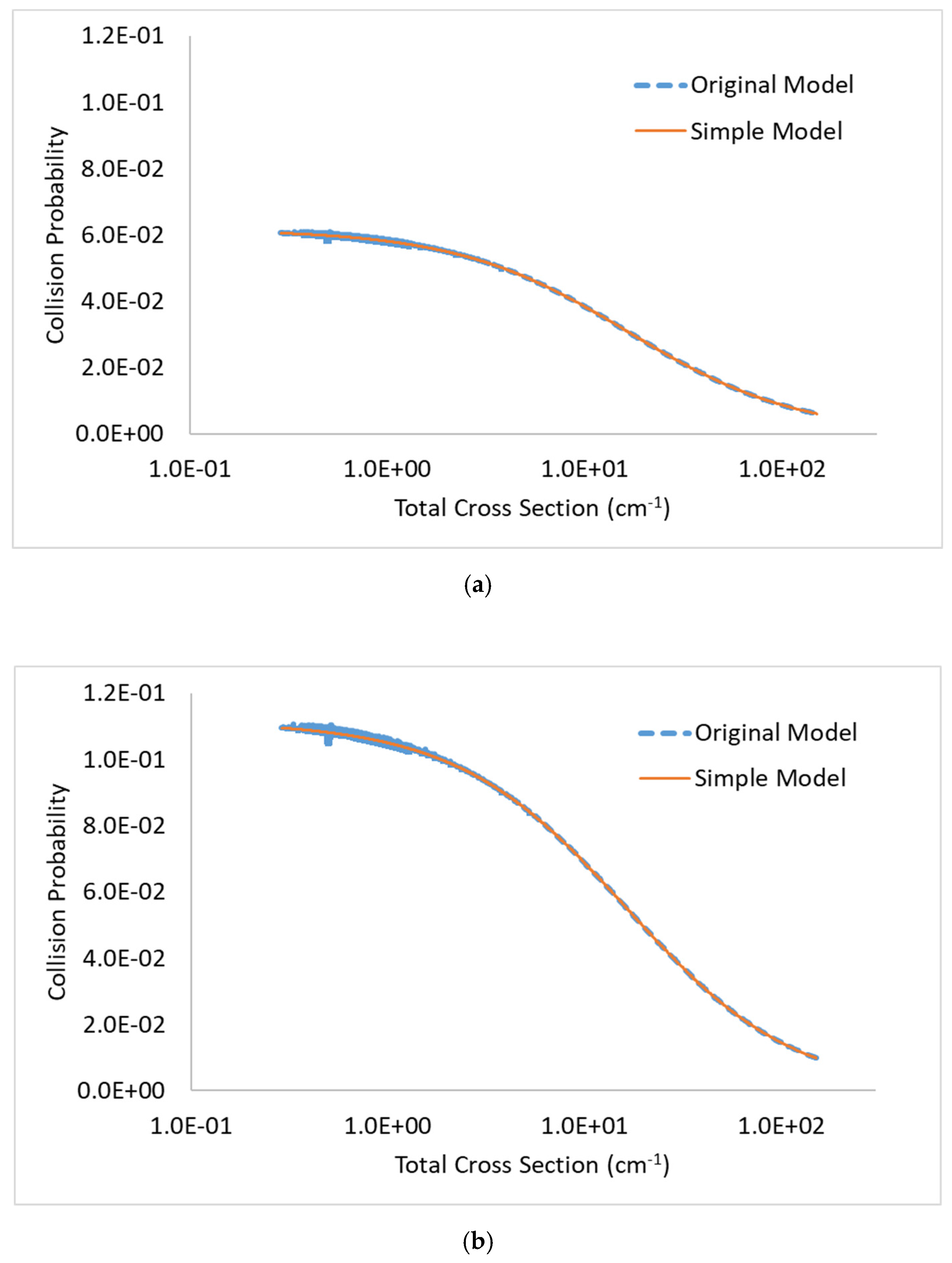
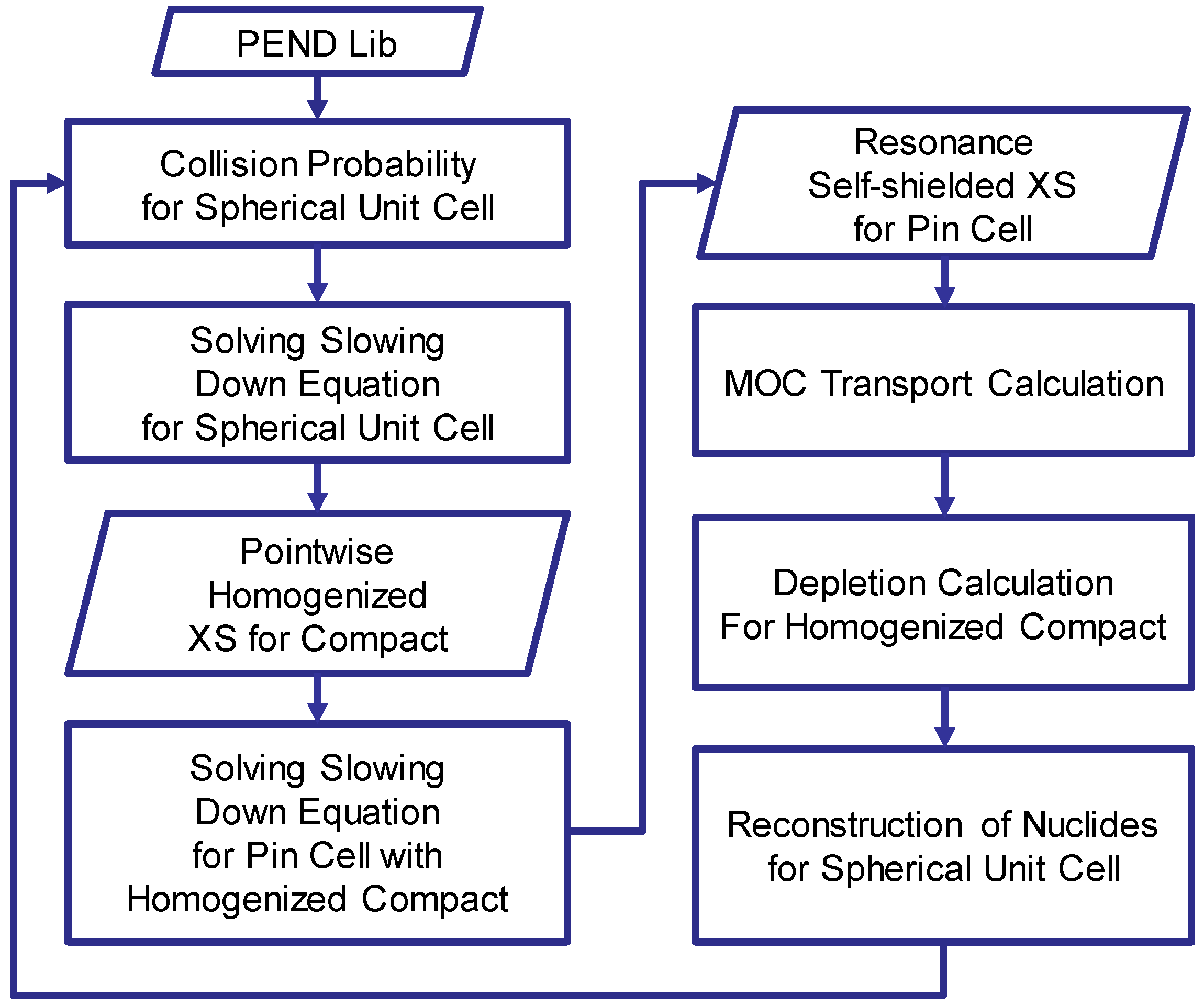
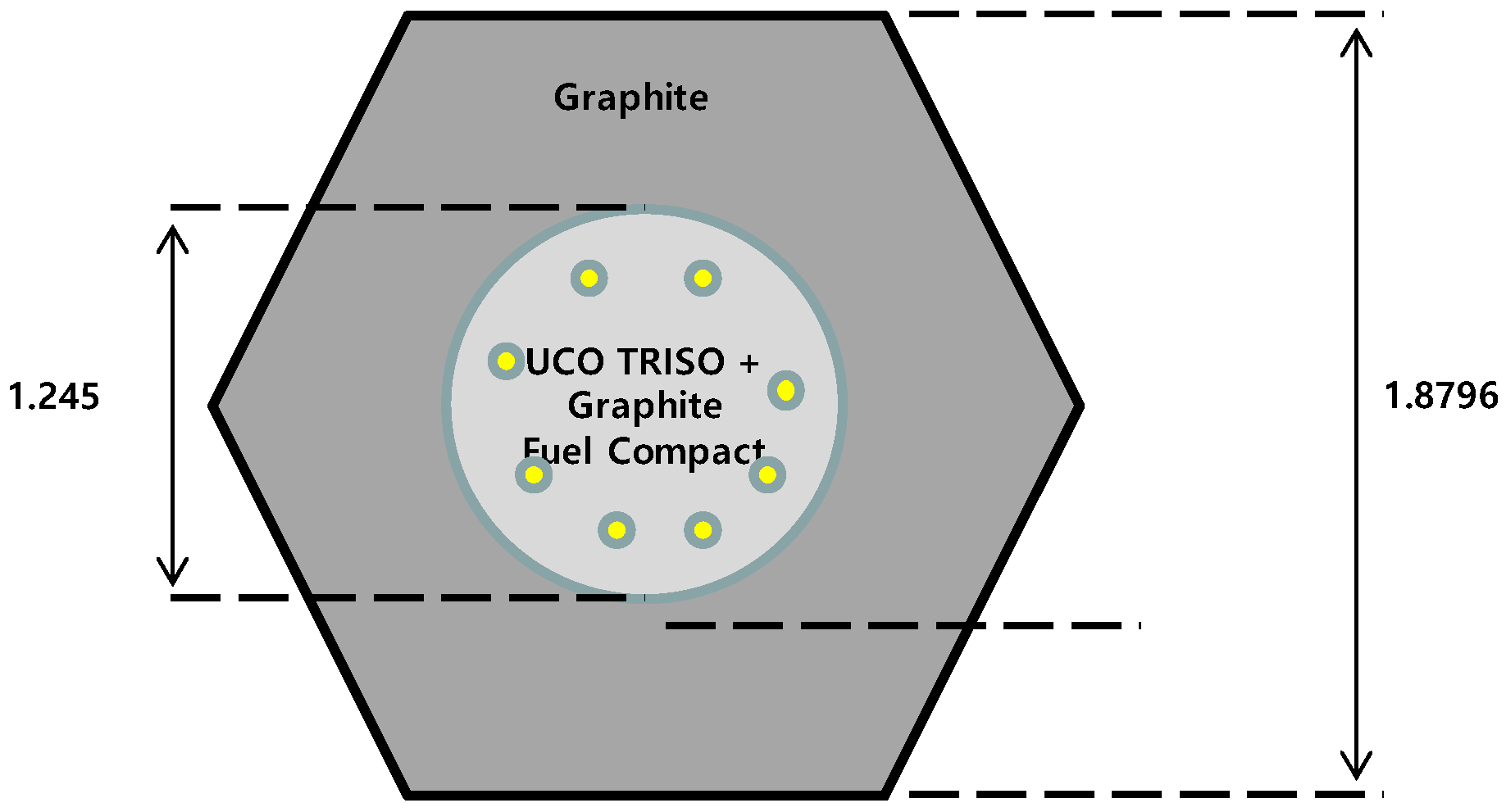
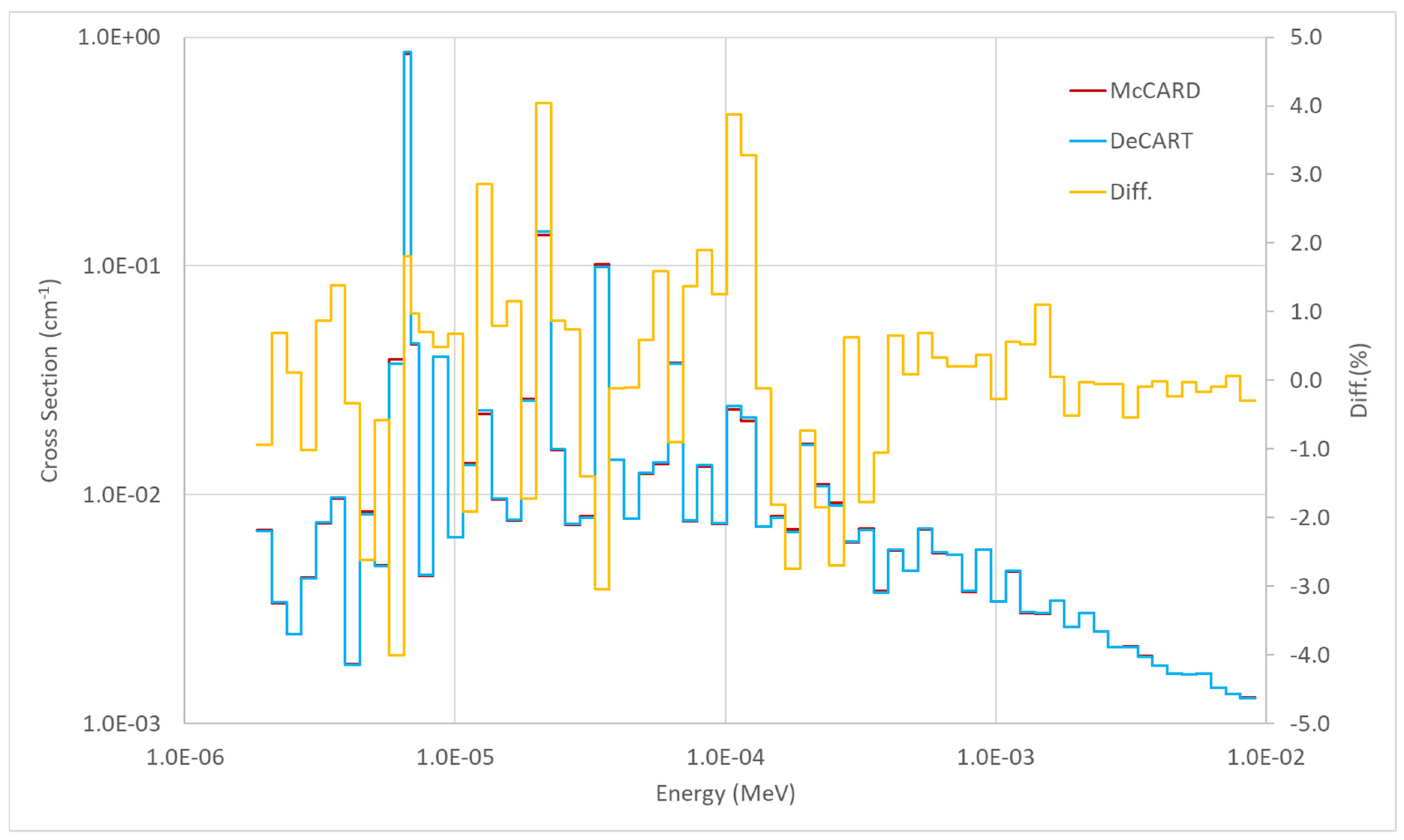
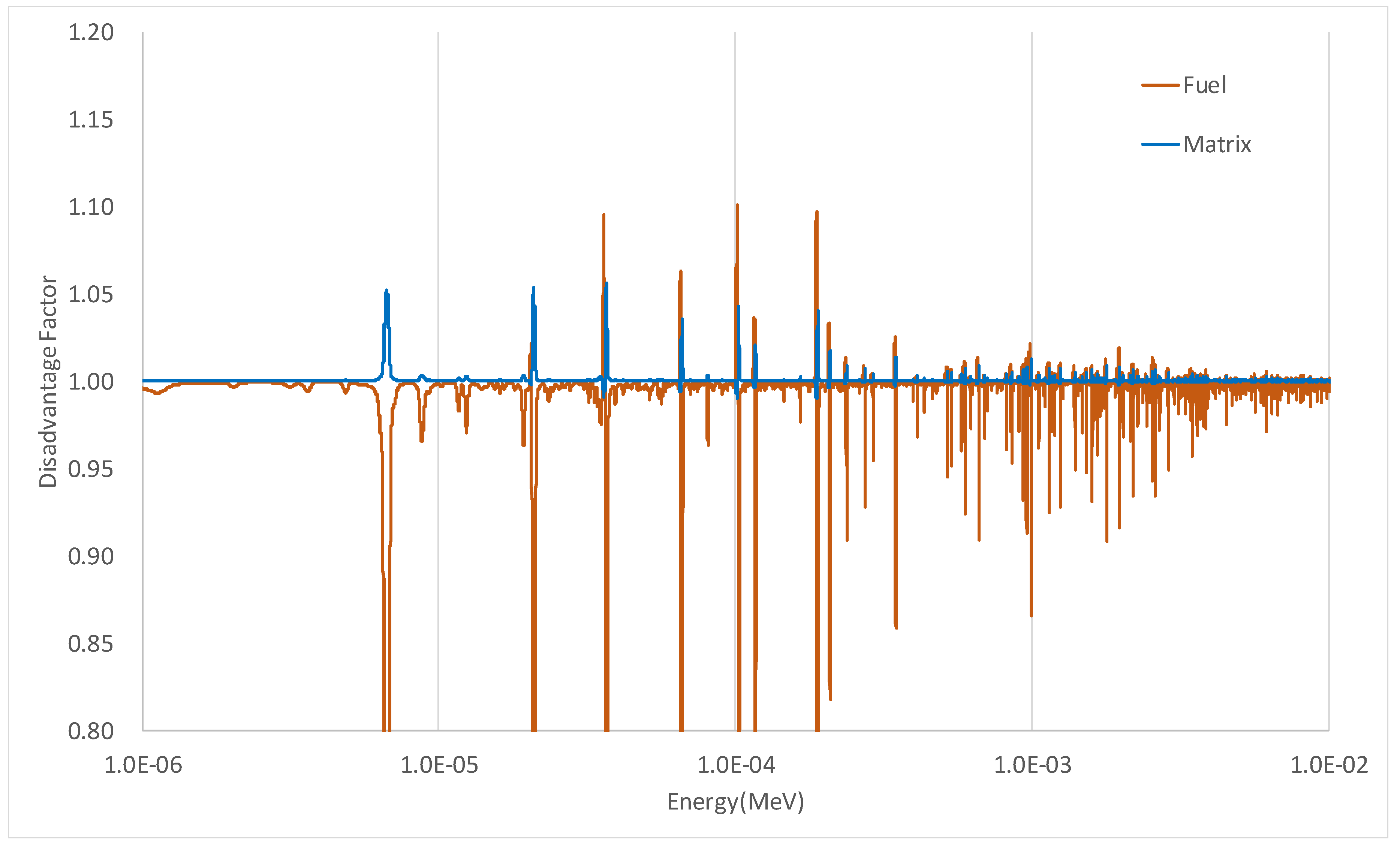
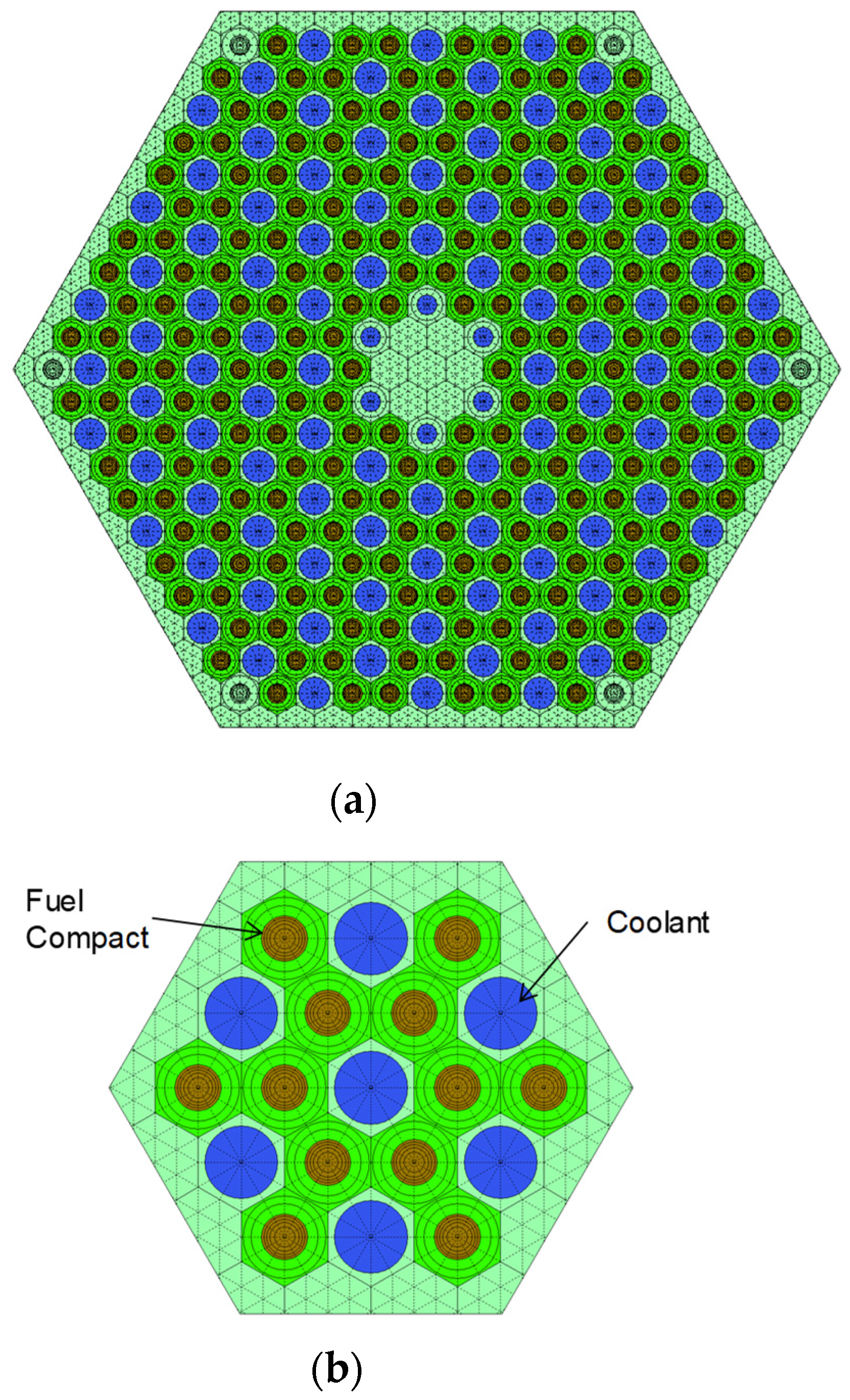
| Material | Nuclide | Number Density (#/barn-cm) | |
|---|---|---|---|
| TRISO Fuel Particle | Kernel | U-235 | 3.70 × 10−3 |
| U-238 | 1.99 × 10−2 | ||
| O-16 | 3.55 × 10−2 | ||
| Graphite | 1.18 × 10−2 | ||
| Porous Carbon | Graphite | 5.02 × 10−2 | |
| IPyC | Graphite | 9.53 × 10−2 | |
| SiC | Si-28 | 4.43 × 10−2 | |
| Si-29 | 2.25 × 10−3 | ||
| Si-30 | 1.49 × 10−3 | ||
| Graphite | 4.81 × 10−2 | ||
| OPyC | Graphite | 9.53 × 10−2 | |
| Compact Matrix | Graphite | 8.27 × 10−2 | |
| Block Graphite | Graphite | 9.28 × 10−2 | |
| Packing Fraction | TEMP = 300 K | |||||
|---|---|---|---|---|---|---|
| Multiplication Factor | Double Het. Effect | |||||
| McCARD(M) (σ ≈ 14 pcm) | DeCART(D) with PSM-DH | Diff.(D-M) (pcm) | McCARD(M) (pcm) | DeCART(D) with PSM-DH (pcm) | Diff.(D-M) (pcm) | |
| 10% | 1.67515 | 1.67490 | −25 | 3687 | 3704 | 17 |
| 15% | 1.59333 | 1.59231 | −102 | 3794 | 3794 | 0 |
| 20% | 1.52335 | 1.52155 | −180 | 3727 | 3685 | −42 |
| 25% | 1.46397 | 1.46208 | −189 | 3537 | 3502 | −35 |
| 30% | 1.41348 | 1.41198 | −150 | 3297 | 3297 | 0 |
| 35% | 1.37090 | 1.36950 | −140 | 3084 | 3091 | 8 |
| 40% | 1.33370 | 1.33324 | −46 | 2839 | 2895 | 55 |
| Packing Fraction | TEMP = 600 K | |||||
|---|---|---|---|---|---|---|
| Multiplication Factor | Double Het. Effect | |||||
| McCARD(M) (σ ≈ 14 pcm) | DeCART(D) with PSM-DH | Diff.(D-M) (pcm) | McCARD(M) (pcm) | DeCART(D) with PSM-DH (pcm) | Diff.(D-M) (pcm) | |
| 10% | 1.63835 | 1.63843 | 8 | 4066 | 4021 | −45 |
| 15% | 1.55027 | 1.54939 | −88 | 4310 | 4231 | −79 |
| 20% | 1.47587 | 1.47463 | −124 | 4256 | 4165 | −90 |
| 25% | 1.41441 | 1.41284 | −157 | 4093 | 3978 | −115 |
| 30% | 1.36300 | 1.36150 | −150 | 3874 | 3741 | −133 |
| 35% | 1.31897 | 1.31854 | −43 | 3577 | 3488 | −89 |
| 40% | 1.28143 | 1.28231 | 88 | 3259 | 3235 | −24 |
| Packing Fraction | TEMP = 900 K | |||||
|---|---|---|---|---|---|---|
| Multiplication Factor | Double Het. Effect | |||||
| McCARD(M) (σ ≈ 14 pcm) | DeCART(D) with PSM-DH | Diff.(D-M) (pcm) | McCARD(M) (pcm) | DeCART(D) with PSM-DH (pcm) | Diff.(D-M) (pcm) | |
| 10% | 1.60965 | 1.61059 | 94 | 4244 | 4189 | −55 |
| 15% | 1.51790 | 1.51730 | −60 | 4622 | 4508 | −114 |
| 20% | 1.44131 | 1.43984 | −147 | 4634 | 4504 | −130 |
| 25% | 1.37792 | 1.37643 | −149 | 4463 | 4343 | −120 |
| 30% | 1.32624 | 1.32421 | −203 | 4256 | 4110 | −146 |
| 35% | 1.28159 | 1.28088 | −71 | 3887 | 3846 | −41 |
| 40% | 1.24432 | 1.24464 | 32 | 3546 | 3575 | 28 |
| Packing Fraction | TEMP = 1100 K | |||||
|---|---|---|---|---|---|---|
| Multiplication Factor | Double Het. Effect | |||||
| McCARD(M) (σ ≈ 14 pcm) | DeCART(D) with PSM-DH | Diff.(D-M) (pcm) | McCARD(M) (pcm) | DeCART(D) with PSM-DH (pcm) | Diff.(D-M) (pcm) | |
| 10% | 1.59459 | 1.59604 | 145 | 4351 | 4304 | −47 |
| 15% | 1.50021 | 1.50045 | 24 | 4755 | 4708 | −47 |
| 20% | 1.42191 | 1.42157 | −35 | 4818 | 4761 | −57 |
| 25% | 1.35817 | 1.35729 | −88 | 4668 | 4637 | −31 |
| 30% | 1.30582 | 1.30466 | −116 | 4462 | 4431 | −31 |
| 35% | 1.26244 | 1.26117 | −127 | 4188 | 4185 | −4 |
| 40% | 1.22552 | 1.22497 | −55 | 3876 | 3926 | 50 |
| Packing Fraction | TEMP = 1100 K | ||
|---|---|---|---|
| McCARD(M) (σ ≈ 14 pcm) | DeCART(D) with PSM-DH | Diff.(D-M) (pcm) | |
| 15% | 1.59923 | 1.59960 | 37 |
| 25% | 1.48566 | 1.48523 | −43 |
| 35% | 1.40028 | 1.39935 | −93 |
| Packing Fraction | TEMP = 1100 K | ||
|---|---|---|---|
| McCARD(M) (σ ≈ 14 pcm) | DeCART(D) with PSM-DH | Diff.(D-M) (pcm) | |
| 15% | 1.65946 | 1.66040 | 94 |
| 25% | 1.57386 | 1.57407 | 21 |
| 35% | 1.50224 | 1.50195 | −29 |
| Burnup (Days) | TEMP = 1200 K, PF = 35% | ||
|---|---|---|---|
| McCARD(M) (σ ≈ 14 pcm) | DeCART(D) with PSM-DH | Diff.(D-M) (pcm) | |
| 0.00 | 1.25293 | 1.25215 | −78 |
| 50.00 | 1.20219 | 1.20136 | −83 |
| 100.00 | 1.18029 | 1.17974 | −56 |
| 150.00 | 1.15836 | 1.15828 | −8 |
| 200.00 | 1.13718 | 1.13711 | −7 |
| 250.00 | 1.11675 | 1.11670 | −5 |
| 300.00 | 1.09726 | 1.09733 | 7 |
| 350.00 | 1.07902 | 1.07912 | 10 |
| 400.00 | 1.06180 | 1.06211 | 31 |
| 450.00 | 1.04615 | 1.04626 | 11 |
| 500.00 | 1.03140 | 1.03149 | 8 |
| 562.50 | 1.01411 | 1.01440 | 28 |
| 625.00 | 0.99865 | 0.99871 | 6 |
| 687.50 | 0.98421 | 0.98426 | 5 |
| 750.00 | 0.97105 | 0.97092 | −13 |
| 812.50 | 0.95877 | 0.95854 | −23 |
| 875.00 | 0.94677 | 0.94700 | 23 |
| 937.50 | 0.93577 | 0.93621 | 44 |
| 1000.00 | 0.92589 | 0.92607 | 18 |
| 1062.50 | 0.91629 | 0.91653 | 24 |
| 1125.00 | 0.90707 | 0.90750 | 43 |
| 1187.50 | 0.89824 | 0.89894 | 70 |
| 1250.00 | 0.89035 | 0.89080 | 45 |
| 1312.50 | 0.88257 | 0.88304 | 47 |
| 1375.00 | 0.87460 | 0.87563 | 103 |
| 1437.50 | 0.86740 | 0.86853 | 113 |
| 1500.00 | 0.86071 | 0.86173 | 102 |
| Half Pitch Size | Compact Radius | Multiplication Factor (PF = 35%) | |||||
|---|---|---|---|---|---|---|---|
| TEMP = 300 K | TEMP = 1100 K | ||||||
| McCARD(M) (σ ≈ 12 pcm) | DeCART(D) with PSM-DH | Diff.(D-M) (pcm) | McCARD(M) (σ ≈ 12 pcm) | DeCART(D) with PSM-DH | Diff.(D-M) (pcm) | ||
| 2.0 | 0.8 | 1.68542 | 1.68352 | −190 | 1.61091 | 1.61089 | −2 |
| 2.0 | 1.0 | 1.58182 | 1.57932 | −250 | 1.49405 | 1.49323 | −82 |
| 2.0 | 1.5 | 1.30827 | 1.30644 | −183 | 1.20270 | 1.20094 | −176 |
| 2.0 | 1.8 | 1.17886 | 1.17840 | −46 | 1.07542 | 1.07315 | −227 |
| TRISO Radius | Fuel Kernel Radius | Multiplication Factor (PF = 35%) | |||||
|---|---|---|---|---|---|---|---|
| TEMP = 300 K | TEMP = 1100 K | ||||||
| McCARD(M) (σ ≈ 18 pcm) | DeCART(D) with PSM-DH | Diff.(D-M) (pcm) | McCARD(M) (σ ≈ 18 pcm) | DeCART(D) with PSM-DH | Diff.(D-M) (pcm) | ||
| 0.0385 | 0.0175 | 1.43830 | 1.43758 | −72 | 1.33052 | 1.33075 | 23 |
| 0.0410 | 0.0200 | 1.39114 | 1.39032 | −82 | 1.28218 | 1.28208 | −10 |
| 0.0460 | 0.0250 | 1.31868 | 1.31744 | −124 | 1.21207 | 1.21103 | −104 |
| 0.0485 | 0.0275 | 1.29118 | 1.28986 | −132 | 1.18695 | 1.18545 | −150 |
| Calculation Module | DeCART with Pre-Generated Library (D) (sec) | DeCART with PSM-DH (P) (sec) | Ratio (P/D) |
|---|---|---|---|
| Resonance Treatment | 785.3 | 477.4 | 0.61 |
| MOC | 1561.3 | 1196.1 | 0.77 |
| Total Calculation | 2374.7 | 1699.4 | 0.72 |
Publisher’s Note: MDPI stays neutral with regard to jurisdictional claims in published maps and institutional affiliations. |
© 2021 by the authors. Licensee MDPI, Basel, Switzerland. This article is an open access article distributed under the terms and conditions of the Creative Commons Attribution (CC BY) license (https://creativecommons.org/licenses/by/4.0/).
Share and Cite
Han, T.-Y.; Cho, J.-Y.; Jo, C.-K.; Lee, H.-C. Extension of Pin-Based Point-Wise Energy Slowing-Down Method for VHTR Fuel with Double Heterogeneity. Energies 2021, 14, 2179. https://doi.org/10.3390/en14082179
Han T-Y, Cho J-Y, Jo C-K, Lee H-C. Extension of Pin-Based Point-Wise Energy Slowing-Down Method for VHTR Fuel with Double Heterogeneity. Energies. 2021; 14(8):2179. https://doi.org/10.3390/en14082179
Chicago/Turabian StyleHan, Tae-Young, Jin-Young Cho, Chang-Keun Jo, and Hyun-Chul Lee. 2021. "Extension of Pin-Based Point-Wise Energy Slowing-Down Method for VHTR Fuel with Double Heterogeneity" Energies 14, no. 8: 2179. https://doi.org/10.3390/en14082179
APA StyleHan, T.-Y., Cho, J.-Y., Jo, C.-K., & Lee, H.-C. (2021). Extension of Pin-Based Point-Wise Energy Slowing-Down Method for VHTR Fuel with Double Heterogeneity. Energies, 14(8), 2179. https://doi.org/10.3390/en14082179






